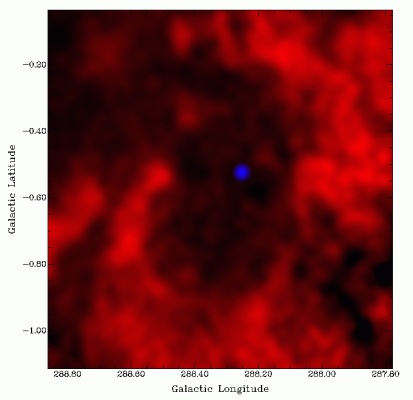A wind bubble around a magnetar
|
B. M. Gaensler (Harvard-Smithsonian Center for Astrophysics, USA); N. M. McClure-Griffiths (ATNF); S. Oey (University of Michigan, USA); M. Haverkorn (Harvard-Smithsonian Center for Astrophysics, USA); J. Dickey (University of Tasmania); A. Green (University of Sydney) The last decade has revealed remarkable diversity in the young neutron star population. Particularly notable is the small population of "magnetars", sources whose persistent X-ray emission and occasional X- and gamma-ray bursts are powered by the energy associated with extreme surface magnetic fields, in excess of 1015 Gauss. Underpinning studies of this new class of objects is the mystery of why some neutron stars are "normal" radio pulsars, while others are exotic magnetars. The Southern Galactic Plane Survey (SGPS; see the 2002 Annual Report), which combines 21-cm HI observations from Parkes and the Compact Array, is now complete. The SGPS provides a wonderful resource for understanding populations such as magnetars in the context of their environment. Examination of SGPS data around the position of the well-known magnetar 1E 1048.15937 reveals a striking cavity in HI, designated as GSH 288.3-0.5-28, that is almost centred on the position of the neutron star. The SGPS data imply that GSH 288.3-0.5-28 is at a distance of approximately 2.7 kpc, and is expanding at a velocity of approximately 7.5 kilometres per second into gas of density ~17 atoms cm-3. Shells like GSH 288.3-0.5-28 are common, and represent wind-blown bubbles powered by massive stars expanding into the interstellar medium. The size and expansion speed of GSH 288.3-0.5-28 then imply that the bubble is several million years old, and has been blown by a wind of mechanical luminosity ~4x1034 ergs per second, corresponding to a single star of initial mass 30 to 40 solar masses. Usually in such cases, the central star is obvious, in the form of a bright O star, supergiant or WR star at the shell's centre. However, even though this field lies in the rich Carina OB1 region, there are no known stars of the appropriate position, distance or luminosity to argue for an association with GSH 288.3-0.5-28. This raises the intriguing possibility that GSH 288.3-0.5-28 was blown by the massive star whose collapse formed 1E 1048.1-5937. The central location of the magnetar within the HI shell suggests that the supernova occurred quite recently. The corresponding blast waves would impact the walls of the HI shell approximately 3000 years after core collapse, producing significant X-ray and radio emission. The lack of such emission requires the neutron star to be very young, consistent with the small ages expected for active magnetars. A common distance of around three kpc is suggested by the properties of both objects. Most neutron star progenitors will have masses near the minimum mass for core collapse, i.e., eight to nine solar masses. However, it is likely that the progenitor of the magnetar 1E 1048.1-5937 was considerably more massive than this. For some other magnetars, possible associations with massive star clusters similarly argue for high-mass progenitors. It thus appears likely that the difference between normal pulsars and magnetars is the progenitor mass. Why should massive stars form magnetars? Recent work has shown that magnetars likely result from rapidly rotating (spin periods approximately one millisecond) proto-neutron stars, in which an efficient large-scale dynamo generates a super-strong magnetic field. Recent calculations on supernova progenitors indicate that stars of initial mass 10 to 15 solar masses produce neutron stars with initial periods 10 to 15 milliseconds, too slow to generate magnetar-like fields. However, more massive stars produce much more rapidly spinning neutron stars. For example, a 35 solar mass progenitor results in a neutron star of initial period three milliseconds, in the range needed to give birth to a magnetar. Within this scenario, a prediction as to the relative birth rates of radio pulsars versus magnetars can be made. If the mass cut between normal pulsars and magnetars is at an initial mass of approximately 25 solar masses, then for a standard initial mass function the magnetar birth rate is expected to be only about 10 per cent of that of radio pulsars. The birth rate estimated from observations of the existing populations of magnetars is already comparable to this. If magnetars indeed form from massive progenitors, then it appears likely that there is no substantial population of such sources yet to be identified. |
|

